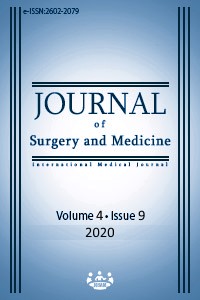Effects of hypercaloric enteral intervention on malnutrition patients with a history of febrile seizure before the age of six
Keywords:
Febrile seizure, Malnutrition, Micronutrients, Body mass index, Enteral nutritionAbstract
Aim: Febrile seizure is the most prevalent (~5%) convulsion in children between 3 to 60 months of age and has been related to iron deficiency. Thus, when it is combined with malnutrition, it may increase negative outcomes. In this study, we present the effects of hypercaloric (1.5 kcal mL-1) nutritional intervention on undernourished children with a history of febrile convulsions prior to the age of 6. Methods: A cohort of 44 patients between ages 1-6 years with a history of a febrile seizure was included in the study. Hypercaloric nutritional intervention was applied to all patients. Baseline patient records containing anthropometrical and micronutrient measurements were compared with the 3rd month and the 6th month visits. All patient records were retrospectively obtained from Istanbul Research and Training Hospital, İstanbul, Turkey. Results: There were significant improvements in the z-scores of weight (P=0.002) and body mass index (P<0.001). Approximately 50% of iron and 25-hydroxyvitamin D3 (25D3) deficient patients were cured and their serum concentrations increased significantly (P<0.001 for both). Treatment did not affect iron concentrations in patients without iron deficiency (P=0.074). Normal concentrations of 25D3, folate, and vitamin B12 improved inside the optimal micronutrient ranges without toxicity. Conclusion: Overall, hypercaloric nutritional intervention abated iron and 25D3 deficiency and significantly improved the z-scores of BMI and weight in malnourished pediatric patients under the age of 6 with a history of febrile seizures without toxicity.
Downloads
References
Leung AK, Hon KL, Leung TN. Febrile seizures: an overview. Drugs in Context. 2018;7:212536-. doi: 10.7573/dic.212536. PubMed PMID: 30038660.
Holmes GL, Ben-Ari Y. The Neurobiology and Consequences of Epilepsy in the Developing Brain. Pediatr Res. 2001;49(3):320-5. doi: 10.1203/00006450-200103000-00004.
Dubé CM, Brewster AL, Baram TZ. Febrile seizures: mechanisms and relationship to epilepsy. Brain Dev. 2009;31(5):366-71. Epub 02/15. doi: 10.1016/j.braindev.2008.11.010. PubMed PMID: 19232478.
Shibasaki K, Suzuki M, Mizuno A, Tominaga M. Effects of body temperature on neural activity in the hippocampus: regulation of resting membrane potentials by transient receptor potential vanilloid 4. J Neurosci. 2007;27(7):1566-75. Epub 2007/02/16. doi: 10.1523/jneurosci.4284-06.2007. PubMed PMID: 17301165; PubMed Central PMCID: PMCPmc6673744.
Idro R, Gwer S, Williams TN, Otieno T, Uyoga S, Fegan G, et al. Iron deficiency and acute seizures: results from children living in rural Kenya and a meta-analysis. PLoS One. 2010;5(11):e14001-e. doi: 10.1371/journal.pone.0014001. PubMed PMID: 21103365.
Jang HN, Yoon HS, Lee EH. Prospective case control study of iron deficiency and the risk of febrile seizures in children in South Korea. BMC Pediatr. 2019;19(1):309. doi: 10.1186/s12887-019-1675-4.
Kocak O, Icagasioglu FD. Demographic and clinical characteristics of children who were hospitalized and followed due to seizures. J Surg Med. 2020;4(7):545-9. doi: 10.28982/josam.773784.
Ferreira A, Neves P, Gozzelino R. Multilevel Impacts of Iron in the Brain: The Cross Talk between Neurophysiological Mechanisms, Cognition, and Social Behavior. Pharmaceuticals (Basel). 2019;12(3). Epub 2019/09/01. doi: 10.3390/ph12030126. PubMed PMID: 31470556; PubMed Central PMCID: PMCPmc6789770.
Schoeman J, Dannhauser A, Kruger M. Malnutrition in paediatric oncology patients2010.
Neyzi O, Günöz H, Furman A, Bundak R, Gokcay G. Türk çocuklarinda vücut ağirliği, boy uzunluğu, baş çevresi ve vücut kitle indeksi referans değerleri. Çocuk Sağlığı ve Hastalıkları Dergisi. 2008;51.
Demir K, Konakci E, Ozkaya G, Kasap Demir B, Ozen S, Aydin M, et al. New Features for Child Metrics: Further Growth References and Blood Pressure Calculations. J Clin Res Pediatr Endocrinol. 2019. Epub 2019/09/03. doi: 10.4274/jcrpe.galenos.2019.2019.0127. PubMed PMID: 31475511.
Bailey RL, West KP, Jr., Black RE. The epidemiology of global micronutrient deficiencies. Ann Nutr Metab. 2015;66 Suppl 2:22-33. Epub 2015/06/06. doi: 10.1159/000371618. PubMed PMID: 26045325.
Duyuran Ö, Acıpayam C, Seringec N, Ipek S, Duyuran R. Etiology of anemia in children aged between 6 months and 18 years. J Surg Med. 2019;3(5):402-5. doi: 10.28982/josam.568900.
Celep G, Durmaz Z, Demir H, Erdoğan Y. Vitamin D status in infancy: What is the solution? J Surg Med. 2019;3(8):579-82. doi: 10.28982/josam.555486.
Unsur E, Kinas B. The relationship between maternal and neonatal vitamin B12 and folate levels, anthropometric measurements, and metabolic indicators. J Surg Med. 2020;4(1):43-7. doi: 10.28982/josam.669066.
Physical status: the use and interpretation of anthropometry. Report of a WHO Expert Committee. World Health Organ Tech Rep Ser. 1995;854:1-452. Epub 1995/01/01. PubMed PMID: 8594834.
Gat-Yablonski G, Phillip M. Nutritionally-induced catch-up growth. Nutrients. 2015;7(1):517-51. doi: 10.3390/nu7010517. PubMed PMID: 25594438.
Yousefichaijan P, Eghbali A, Rafeie M, Sharafkhah M, Zolfi M, Firouzifar M. The relationship between iron deficiency anemia and simple febrile convulsion in children. J Pediatr Neurosci. 2014;9(2):110-4. doi: 10.4103/1817-1745.139276. PubMed PMID: 25250062.
Downloads
- 267 608
Published
Issue
Section
How to Cite
License
Copyright (c) 2020 Eda Sünnetçi Silistre, Özlem Özpenpe, Halil Uğur Hatipoğlu, Ali Doğan, Fatih Ozdener
This work is licensed under a Creative Commons Attribution-NonCommercial-NoDerivatives 4.0 International License.
















